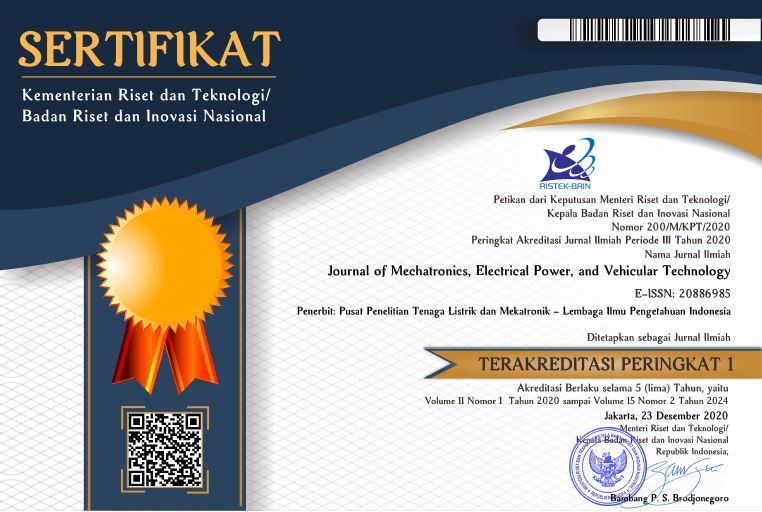Water quality assessment monitoring system using fuzzy logic and the internet of things
Abstract
Keywords
Full Text:
PDFReferences
Howard, G., Bartram, J., Williams, A., Overbo, A., Fuente, D., and Geere, J. A., “Domestic water quantity, service level and health,” World Health Organization, 2020.
El Gaayda, Jamila, et al., "Optimization of turbidity and dye removal from synthetic wastewater using response surface methodology: Effectiveness of Moringa oleifera seed powder as a green coagulant," Journal of Environmental Chemical Engineering, 10(1), pp. 106988, 2022.
Tomperi, J., Isokangas, A., Tuuttila, T., and Paalova, M., "Functionality of turbidity measurement under changing water quality and environmental conditions," Environmental technology, 43 (7), pp. 1093-1101, 2022.
Habib, M. A., Rahman, M. T., Ferdous, J., Hoque, M. M., and Rasheduzzaman, M., "Farmers Perception and Salinity Driven Fresh Water Scarcity in Coastal Bangladesh," in Towards Water Secure Societies: Coping with Water Scarcity and Quality Challenges, pp. 173-182, 2021.
Nel, T., Hardie, A. G., and Clarke, C. E., "Simple and multivariate linear regression models for pH conversion between measurement techniques," Communications in Soil Science and Plant Analysis, 53 (14), pp. 1797-1808, 2022.
H. Fakhrurroja, C. Machbub, A. S. Prihatmanto, and A. Purwarianti, “Multimodal Interaction System for Home Appliances Control,” International Journal of Interactive Mobile Technologies (iJIM), 14 (15), 2020.
D. Yadav, S. S. Chouhan, S. K. Vishvakarma, and B. Raj, “Application Specific Microcontroller Design for Internet of Things Based Wireless Sensor Network,” Sensor Letters, 16 (5), pp. 374–385, 2018.
A. Munandar et al., “Design and development of an IoT-based smart hydroponic system,” in 2018 International Seminar on Research of Information Technology and Intelligent Systems (ISRITI), pp. 582–586, 2018.
M. Babiuch and J. Postulka, Smart Home Monitoring System Using ESP32 Microcontrollers. IntechOpen, pp. 82-101, 2020.
E. Rijanto, E. Adiwiguna, A. P. Sadono, M. H. Nugraha, O. Mahendra, and R. D. Firmansyah, “A new design of embedded monitoring system for maintenance and performance monitoring of a cane harvester tractor,” Journal of Mechatronics, Electrical Power, and Vehicular Technology, 11(2), pp. 102–110, 2020.
Chin, J., Callaghan, V., and Allouch, S.B., "The Internet-of Things: Reflections on the past, present and future from a user-centered and smart environment perspective," Journal of Ambient Intelligence and Smart Environments, 11 (1), pp. 4569, 2019.
P. B. Bokingkito and L. T. Caparida, “Using Fuzzy Logic for Realtime Water Quality Assessment Monitoring System,” in Proceedings of the 2018 2nd International Conference on Automation, Control and Robots, pp. 21–25, 2018.
M. F. Johan, S. Abdullah, N. S. Mohamad Hadis, S. Omar, and A. Zanal, “Development and Implementation of Water Quality Assessment Monitoring (WQAM) System using the Internet of Things (IoT) in Water Environment,” Journal of Electronic Voltage and Application (JEVA), 2 (2), pp. 1-12, 2021.
Ainannisa, N., Silalahi, D. K., and Pangaribuan, P., Automatic Water Monitoring and Draining System Manufacturing for Aquascape Based on Water Quality Using Fuzzy Logic Method. in: Triwiyanto, T., Rizal, A., and Caesarendra, W., (eds) Proceeding of the 3rd International Conference on Electronics, Biomedical Engineering, and Health Informatics. Lecture Notes in Electrical Engineering, vol 1008. Springer, Singapore, 2023.
Abdallah, Emad E., Eleisah, W., and Otoom, A. F., "Intrusion Detection Systems using supervised machine learning techniques: a survey," Procedia Computer Science, 201, pp. 205-212, 2022.
Javaid, M., Haleem, A., Rab, S., Singh, R.P., and Suman, R., "Sensors for daily life: A review," Sensors International 2, p.100121, 2021.
Nemčeková, K. and Labuda, J., "Advanced materials-integrated electrochemical sensors as promising medical diagnostics tools: A review," Materials Science and Engineering: C 120, p. 111751, 2021.
Boyd, Claude E., Water quality: an introduction. Springer Nature, 2019.
Uddin, Md. G., Nash, S., and Olbert, A. I., "A review of water quality index models and their use for assessing surface water quality," Ecological Indicators, 122, p. 107218, 2021.
N. H. Omer, “Water quality parameters,” Water quality science, assessments and policy, vol. 18, pp. 1–34, 2019.
I. L. Tarigan, “Physical, chemical, and biological analysis of drinking water quality in Tulungagung regency, East Java,” Medical Laboratory Analysis and Sciences Journal, vol. 2, no. 1, pp. 23–30, 2020.
V. Azteria and E. Rosya, “Drinking Water Quality of Water Refill Station in Gebang Raya Tangerang,” Jurnal Kesehatan Lingkungan (Journal of Environmental Health), vol. 15, no. 2, pp. 120-126, 2023.
Kementrian Kesehatan Republik Indonesia, “Peraturan Menteri Kesehatan Nomor 2 Tahun 2023 tentang Peraturan Pelaksanaan Peraturan Pemerintah Nomor 66 Tahun 2014 tentang Kesehatan Lingkungan,”.
Oliva, D., et al., "Fuzzy simheuristics: Solving optimization problems under stochastic and uncertainty scenarios," Mathematics, 8 (12), p. 2240, 2020.
V. Rexhepi and P. Nakov, “Condition assessment of power transformers status based on moisture level using fuzzy logic techniques,” Journal of Mechatronics, Electrical Power, and Vehicular Technology, 9 (1), pp. 17–24, 2018.
H. Fakhrurroja, S. A. Mardhotillah, O. Mahendra, A. Munandar, M. I. Rizqyawan, and R. P. Pratama, “Automatic pH and Humidity Control System for Hydroponics Using Fuzzy Logic,” in 2019 International Conference on Computer, Control, Informatics and its Applications (IC3INA), pp. 156–161, 2019.
Permatasari, Y., Firdaus, M. R., Zuhdi, H., Fakhrurroja, H., and Musnansyah, A., “Development of IoT Control System Prototype for Flood Prevention in Bandung Area,” JOIV: International Journal on Informatics Visualization, 7(3), pp. 1016-1021, 2023.
Jerry, M. Mendel, Uncertain rule-based fuzzy systems: Introduction and New Directions. Springer, 2019.
Höhle, Ulrich, "On the mathematical foundations of fuzzy set theory," Fuzzy Sets and Systems, 444, pp. 1-9, 2022.
A. Jain and A. Sharma, “Membership function formulation methods for fuzzy logic systems: A comprehensive review,” Journal of Critical Reviews, vol. 7, no. 19, pp. 8717–8733, 2020.
Zhang, B., Li, C. -C., Dong, Y., and Pedrycz, W., "A comparative study between analytic hierarchy process and its fuzzy variants: a perspective based on two linguistic models," IEEE Transactions on Fuzzy Systems, 29 (11), pp. 3270-3279, 2020.
Rumbaugh, J., Jacobson, I., and Booch, G., "The unified modeling language reference manual," Addison-Wesley, 1999.
Article Metrics
Metrics powered by PLOS ALM
Refbacks
- There are currently no refbacks.
Copyright (c) 2023 Journal of Mechatronics, Electrical Power, and Vehicular Technology

This work is licensed under a Creative Commons Attribution-NonCommercial-ShareAlike 4.0 International License.















